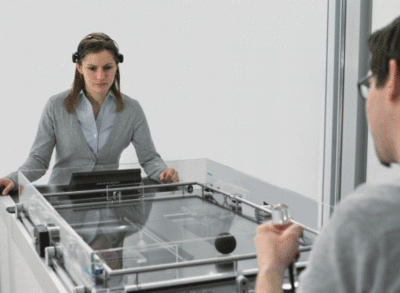
Contact Details:
Festo (PTY) Ltd
18 - 26 Electron Ave
Isando
Kempton Park
Gauteng
1600
South Africa
Tel: +27 (0)8600 33786
Fax: +27 (0)11 974-2157
Send Enquiry | Company Information

Festo helps bridge gaps between human and machine with cognitive bionics
Product News Friday, November 2, 2012: Festo (PTY) Ltd
It is becoming easier to comprehend the factory of the future with recent brain-computer interface (BCI), voice command and image recognition technology from Festo.
The company created a buzz at this year’s Hannover Trade Fair when it showcased its rendition of a famous 1970s table tennis videogame, which, with a modern twist, uses carefully rehearsed thought patterns to control the racquets using only a player’s mind. The Bionic Handling Assistant 3.0 also sparked interest with its structural resilience, versatility and performance – all at the control of viable voice control and image recognition interface systems.
The CogniGame is much like its original format, only Festo has implemented the virtual game on a real court built using Festo motion components. The court features a linear axis on each end which provides the left/right movement of each player’s racquet. One player controls the racquet by pressing a lever, but what makes the CogniGame exciting is that the opposing player controls the racquet using thought alone, via a brain-computer interface, or BCI.
BCI technology measures voltage fluctuations on the surface of the user’s head – as with electroencephalography (EEG) via a series of electrodes. This creates a communication channel between the brain and the hardware without any need for interaction from the user via voice or input devices. Festo worked closely with CogniWare to develop this software solution that uses thoughts and biosignals to create instructions.
The concepts found in the CogniGame have practical implications in the modern factory by facilitating faster communication between humans and machines. In the factory of tomorrow, not all work sequences will be automated, so new operating sequences and concepts are needed to enable better communication, whether using joysticks, voice input and other interfaces.
Originally based on the Festo elephant trunk, which was awarded the German Future Award in 2010, the Bionic Handling Assistant (BHA) 3.0 is a highly flexible assistance system that permits safe and direct contact between people and technology. It features eleven degrees of freedom, and can move freely in all directions within a factory environment.
This system allows for close human/machine interaction as it doesn’t pose any danger to operators in the event of a collision. The result is that not all factory areas need to be cordoned off to prevent people from getting too close as is the case with more conventional factory robots.
The inclusion of voice command and image recognition technologies means that the BHA 3.0 can grip objects independently. A miniaturised camera in the gripper module registers the working space, detects target objects, follows them, and initiates the command to grip at the right moment. Voice commands using an appropriate interface can further trigger the BHA 3.0 to execute a range of tasks easily and safely.
